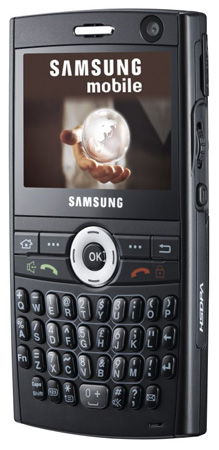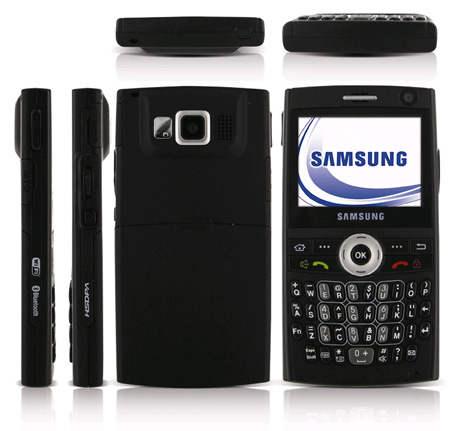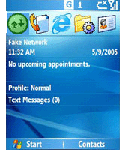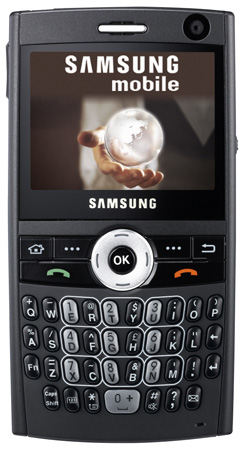Original URL: https://www.theregister.com/2007/04/15/review_samsung_i600/
Samsung SGH-i600 Ultra Edition smartphone
Would-be BlackBerry beater from the consumer electronics giant
Posted in Personal Tech, 15th April 2007 09:59 GMT
Review This is the first Samsung smartphone that features 1.8Mbps high-speed downlink packet access (HSDPA). In addition, 3G UMTS, GSM/GPRS/EDGE connectivity is supported, along with Wi-Fi and Bluetooth. It also supports web applications such as podcasting and RSS Reader.

The handset itself is extremely compact, measuring 11.3 x 5.9 x 1.2cm and weighing in at a very lightweight 105g. It feels robust and well made and it can certainly withstand the day-to-day bumps of a busy lifestyle - even just trying to crowbar the back cover off to put a SIM card in was a traumatic experience. The black casing has a tactile feel and provides a comfortable grip. It has a large, beautifully clear 2.3in colour screen, which offers 65,536 colours - the resolution's 320 x 240 pixels - on a TFT LCD display. A key feature of the i600 is its micro QWERTY keyboard, which is surprisingly fat finger-friendly, unlike many of the micro keyboards found on similar devices.
Sadly, the headphone socket shares the charger connection point - which also doubles as the USB port, so you cannot charge while listening to music or using the headphones as a handsfree set. Navigating around the device is remarkably easy. Most of the main functions appear in the Start menu accessible by pressing one of the hotkeys on the left of the scroll wheel. These hotkeys offer a number of options when tapped, which change according to what's on the screen. The Home key, as you'd expect brings you neatly back to the main window, that shows any due appointments, missed calls, emails and icons for primary applications.
There seems to be some confusion over what the difference actually is between a smart phone and PDA phone. Many manufacturers commonly interchange between the two terms with out any real consistency. Most smartphone devices have micro keyboards - but this is by no means a hard and fast rule. Typically a smartphone is a device that also features PDA functionality and runs a scaled down variation of Windows Mobile designed specifically for mobile phones. Thus they could be referred to as a phone first and a PDA second. Smartphones also generally have a longer battery life and cannot be customised quite as much. But if you primarily use only the calendar and contact features of a PDA anyway, something like the Samsung SGH-i600 is perfect.

Samsung claims up to 6.5 hours talktime purely on 2G and around 3.5 hours on 3G and an average of just over 300 hours on standby. With reasonable daily use, including logging on several times a day for roughly 30 minutes or so and listening to music on the tube journey to work, the i600 happily lasted a few days without requiring charge – which is what you'd expect from a device like this.
Windows Mobile 5.0 provided no problem in synchronising successfully with Microsoft Outlook, sharing the contact, task, and calendar data. The i600 can also synchronise email. However, constantly switching the T9 predictive text input system on and off might prove to be a pain, as most emails require a response and this makes it difficult to reply with more than a couple of lines.
Call quality was superb with more than adequate volume and, unlike many similar devices, you don't feel like you're talking into a pocket calculator. The i600 is a tri-band phone supporting 900, 1800 and 1900 MHz frequencies. Depending on whether your network supports HSDPA – we were using Vodafone, which does – you can also connect the i600 straight to your laptop where it will act as a broadband speed modem. Apple users will need to purchase a third-party piece of software to allow the phone to synchronise to their Mac. Naturally.
New to Windows Mobile?
 Windows Mobile is Microsoft's system software for handheld devices - phones, smart phones, personal digital assistants (PDAs) and so on. It looks a lot like the PC version of Windows, and the two operating systems can share data, but not applications. Windows Mobile uses applications specifically tailored for it, even though they may have the same names as their PC equivalents. Like Windows XP and Vista, Windows Mobile applications are accessed via a Start menu, but there's no taskbar and Trash icon, and many of the control panels are very different. If you've used Windows XP, Windows Mobile will feel familiar but not exactly the same.
Windows Mobile is Microsoft's system software for handheld devices - phones, smart phones, personal digital assistants (PDAs) and so on. It looks a lot like the PC version of Windows, and the two operating systems can share data, but not applications. Windows Mobile uses applications specifically tailored for it, even though they may have the same names as their PC equivalents. Like Windows XP and Vista, Windows Mobile applications are accessed via a Start menu, but there's no taskbar and Trash icon, and many of the control panels are very different. If you've used Windows XP, Windows Mobile will feel familiar but not exactly the same.

The i600 is rich with features including a video player (supporting H.263, H.264, MPEG4, WMV) and video recording (MPEG 4), Windows Media Player 5.0, plus two digital cameras. One is a 1.3 Megapixel camera with digital zoom (x2) and auto focus located on the back of the handset, the other is a VGA camera located on the front for 3G video calling, allowing the user to have a face-to-face call with any 3G compatible mobile phone user. The phone also comes with 64MB RAM and 128MB ROM memory plus a MicroSD slot expandable up to 2GB.
Samsung couldn't confirm what other networks are taking the i600, or even if the device will be sold as a stand alone offering, but it will be available on Orange at the end of April. Pricing from the Orange network is also yet to be officially confirmed.
Verdict
The i600 is difficult to fault. Really. Compact and well-built, it is an ideal smartphone device. Even the tiny elastic-attached plastic covers to the different ports seem as though they might last as long as the handset itself. The micro keyboard might take some getting used to if you are unfamiliar with these types of devices and the mixture of grey and black colouring on the keyboard could cause a little confusion at first.
Windows Mobile 5.0 is surprisingly easy to navigate and the keypad is well laid out: with two soft keys either side of the click wheel and a one-click thumbwheel on the right hand side of the device. Unfortunately, we can't comment on value for money, as no pricing plan whatsoever was available at time of review. However, some websites have the device listed at around the £389.95 mark - given the BlackBerry 8800 is listed from anywhere between £299.99 and £324.99, it seems early indications point to it being a little more expensive than the standalone 8800.